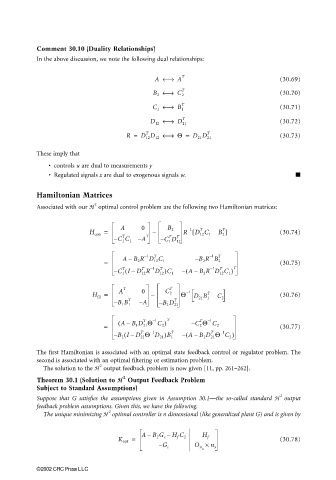Page 904 - The Mechatronics Handbook
P. 904
0066_Frame_C30 Page 15 Thursday, January 10, 2002 4:43 PM
Comment 30.10 (Duality Relationships)
In the above discussion, we note the following dual relationships:
T
A ←→ A (30.69)
T
B 2 ←→ C 2 (30.70)
T
C 1 ←→ B 1 (30.71)
T
D 12 ←→ D 21 (30.72)
T
T
R = D 12 D 12 ←→ Θ = D 21 D 21 (30.73)
These imply that
• controls u are dual to measurements y
• Regulated signals z are dual to exogenous signals w.
Hamiltonian Matrices
2
Associated with our H optimal control problem are the following two Hamiltonian matrices:
H con = A 0 – B 2 R [ D 12 C 1 B 2 ] (30.74)
1
–
T
T
T
T
T
– C 1 C 1 – A T – C 1 D 12
1
1
T
–
–
–
= AB 2 R D 12 C 1 – B 2 R B 2 T (30.75)
(
T T – 1 T – 1 T T
–
– C 1 ID 12 R D 12 )C 1 ( – AB 2 R D 12 C 1 )
–
T T
H fil = A 0 – C 2 Θ – 1 D 21 B 1 T C 2 (30.76)
T
– B 1 B 1 T – A – B 1 D 21
1
–
–
T
T
1
–
= ( AB 1 D 21 Θ C 2 ) T – C 2 Θ C 2 (30.77)
(
T
–
1
–
T
1
–
– B 1 ID 21 Θ D 21 )B 1 T ( – AB 1 D 21 Θ C 2 )
–
The first Hamiltonian is associated with an optimal state feedback control or regulator problem. The
second is associated with an optimal filtering or estimation problem.
2
The solution to the H output feedback problem is now given [11, pp. 261–262].
Theorem 30.1 (Solution to HH 2 Output Feedback Problem
Subject to Standard Assumptions)
2
Suppose that G satisfies the assumptions given in Assumption 30.1—the so-called standard H output
feedback problem assumptions. Given this, we have the following.
2
The unique minimizing H optimal controller is n dimensional (like generalized plant G) and is given by
–
AB 2 G c – H f C 2 H f
K opt = (30.78)
– G c O n × n y
u
©2002 CRC Press LLC

